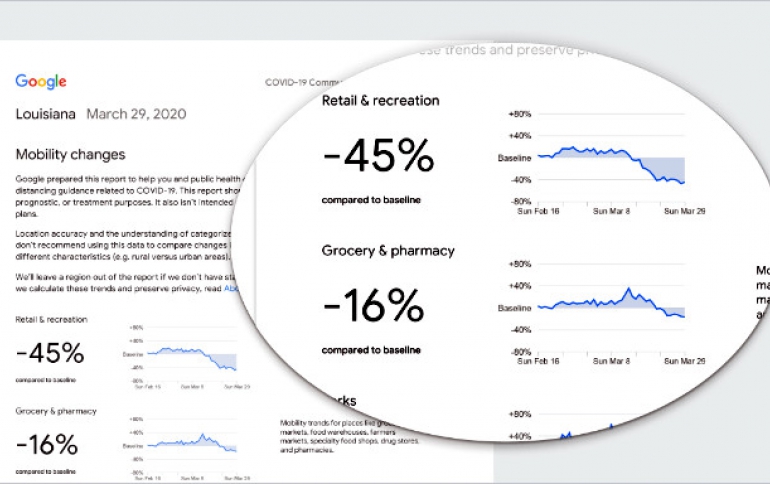
Google Shares Data on How COVID-19 Lockdown Impacts Movement in Cities
Google is releasing new data about how the coronavirus pandemic has cut down on foot traffic to transit centers, retail stores and public parks in more than 130 countries.
In Google Maps, Google uses aggregated, anonymized data showing how busy certain types of places are—helping identify when a local business tends to be the most crowded.
The company has started publishing an early release of the COVID-19 Community Mobility Reports to provide insights into what has changed in response to work from home, shelter in place, and other policies aimed at flattening the curve of this pandemic.
The reports use aggregated, anonymized data to chart movement trends over time by geography, across different high-level categories of places such as retail and recreation, groceries and pharmacies, parks, transit stations, workplaces, and residential. The reports will show trends over several weeks, with the most recent information representing 48-to-72 hours prior. While Google displays a percentage point increase or decrease in visits, it is not sharing the absolute number of visits. To protect people’s privacy, no personally identifiable information, like an individual’s location, contacts or movement, is made available at any point.
Google plans to release these reports globally, initially covering 131 countries. Given the urgent need for this information, where possible Google will also provide insights at the regional level. In the coming weeks, Google will work to add additional countries and regions.
Here is what Google Health Chief Health Officer said:
In addition to other resources public health officials might have, we hope these reports will help support decisions about how to manage the COVID-19 pandemic. For example, this information could help officials understand changes in essential trips that can shape recommendations on business hours or inform delivery service offerings. Similarly, persistent visits to transportation hubs might indicate the need to add additional buses or trains in order to allow people who need to travel room to spread out for social distancing. Ultimately, understanding not only whether people are traveling, but also trends in destinations, can help officials design guidance to protect public health and essential needs of communities.
In addition to the Community Mobility Reports, Google is collaborating with select epidemiologists working on COVID-19 with updates to an existing aggregate, anonymized dataset that can be used to better understand and forecast the pandemic.
Google says that the insights are created with aggregated, anonymized sets of data from users who have turned on the Location History setting, which is off by default. Users who have Location History turned on can choose to turn the setting off at any time from their Google Account, and can always delete Location History data directly from their Timeline.
The charts show how the coronavirus has brought hard-hit Italy and Spain. Both saw visits to retail and recreation locations such as restaurants and movie theaters plunge 94%. The two Mediterranean countries, along with France, saw the sharpest drops in people passing through transportation hubs like railway or metro stations.
The United Kingdom, France and Philippines had declines of more than 80% while India, which went into a sudden 21-day lockdown on March 25, was also notable at 77%.
Germany, which has the third-highest caseload but a relatively low number of fatalities thanks to widespread early testing for COVID-19, has taken a less radical approach with the number of people visiting workplaces down by 39%, the data show.
In the United States, where state responses have varied greatly, and in Australia, where good weather initially prompted many people to go the beach before social distancing measures were ratcheted up, the drops were less steep at under 50%.
In Japan and Sweden, where authorities have not imposed harsh restrictions, visits to retail and recreation sites fell by roughly only a quarter. Sweden has sought to minimize disruption to social and economic life while its caseload remains low. Visits to restaurants, shopping centres and cinemas, for example, have declined by just 24%.
Numbers going to grocery markets and pharmacies have fallen by 10%, while trips to the park are actually up by 43% as people head out to enjoy the Scandinavian spring. Going out for a walk or a jog is up in Denmark, Estonia and Finland too.
The number of people spending more time in residential areas is up by 5% in Sweden, whereas in Italy and Spain it has increased by 24% and 22% respectively as people are confined to their homes.
In South Korea, which has successfully contained a large outbreak through aggressive testing and contact tracing, the decline was just 19%.
Grocery store visits surged in Singapore, the United Kingdom and elsewhere as travel restrictions were set to go into place. Visits to parks spiked in March in some San Francisco Bay Area counties under lockdown in California, forcing them to later put the sites off limits.
California, which was the first in the U.S. with a statewide lockdown, cut visits to retail and recreation locations by half. In New York state, the slide in such visits was gradual as officials waited to impose strict curbs but they eventually fell 62%.
More information can be found at this link



















